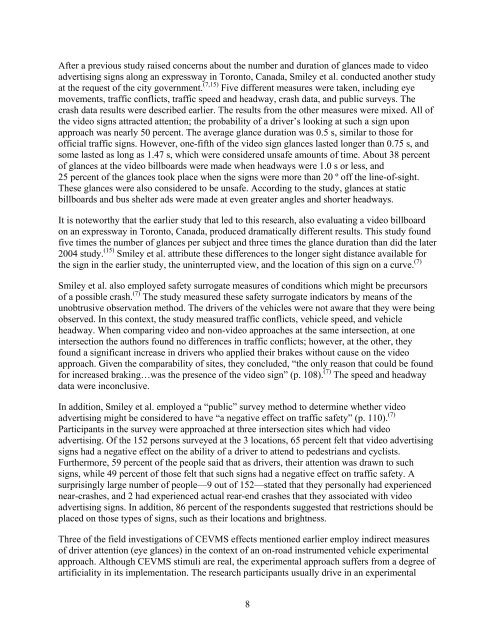The Effects of Commercial Electronic Variable Message Signs ...
The Effects of Commercial Electronic Variable Message Signs ...
The Effects of Commercial Electronic Variable Message Signs ...
Create successful ePaper yourself
Turn your PDF publications into a flip-book with our unique Google optimized e-Paper software.
After a previous study raised concerns about the number and duration <strong>of</strong> glances made to video<br />
advertising signs along an expressway in Toronto, Canada, Smiley et al. conducted another study<br />
at the request <strong>of</strong> the city government. (7,15) Five different measures were taken, including eye<br />
movements, traffic conflicts, traffic speed and headway, crash data, and public surveys. <strong>The</strong><br />
crash data results were described earlier. <strong>The</strong> results from the other measures were mixed. All <strong>of</strong><br />
the video signs attracted attention; the probability <strong>of</strong> a driver’s looking at such a sign upon<br />
approach was nearly 50 percent. <strong>The</strong> average glance duration was 0.5 s, similar to those for<br />
<strong>of</strong>ficial traffic signs. However, one-fifth <strong>of</strong> the video sign glances lasted longer than 0.75 s, and<br />
some lasted as long as 1.47 s, which were considered unsafe amounts <strong>of</strong> time. About 38 percent<br />
<strong>of</strong> glances at the video billboards were made when headways were 1.0 s or less, and<br />
25 percent <strong>of</strong> the glances took place when the signs were more than 20 º <strong>of</strong>f the line-<strong>of</strong>-sight.<br />
<strong>The</strong>se glances were also considered to be unsafe. According to the study, glances at static<br />
billboards and bus shelter ads were made at even greater angles and shorter headways.<br />
It is noteworthy that the earlier study that led to this research, also evaluating a video billboard<br />
on an expressway in Toronto, Canada, produced dramatically different results. This study found<br />
five times the number <strong>of</strong> glances per subject and three times the glance duration than did the later<br />
2004 study. (15) Smiley et al. attribute these differences to the longer sight distance available for<br />
the sign in the earlier study, the uninterrupted view, and the location <strong>of</strong> this sign on a curve. (7)<br />
Smiley et al. also employed safety surrogate measures <strong>of</strong> conditions which might be precursors<br />
<strong>of</strong> a possible crash. (7) <strong>The</strong> study measured these safety surrogate indicators by means <strong>of</strong> the<br />
unobtrusive observation method. <strong>The</strong> drivers <strong>of</strong> the vehicles were not aware that they were being<br />
observed. In this context, the study measured traffic conflicts, vehicle speed, and vehicle<br />
headway. When comparing video and non-video approaches at the same intersection, at one<br />
intersection the authors found no differences in traffic conflicts; however, at the other, they<br />
found a significant increase in drivers who applied their brakes without cause on the video<br />
approach. Given the comparability <strong>of</strong> sites, they concluded, “the only reason that could be found<br />
for increased braking…was the presence <strong>of</strong> the video sign” (p. 108). (7) <strong>The</strong> speed and headway<br />
data were inconclusive.<br />
In addition, Smiley et al. employed a “public” survey method to determine whether video<br />
advertising might be considered to have “a negative effect on traffic safety” (p. 110). (7)<br />
Participants in the survey were approached at three intersection sites which had video<br />
advertising. Of the 152 persons surveyed at the 3 locations, 65 percent felt that video advertising<br />
signs had a negative effect on the ability <strong>of</strong> a driver to attend to pedestrians and cyclists.<br />
Furthermore, 59 percent <strong>of</strong> the people said that as drivers, their attention was drawn to such<br />
signs, while 49 percent <strong>of</strong> those felt that such signs had a negative effect on traffic safety. A<br />
surprisingly large number <strong>of</strong> people—9 out <strong>of</strong> 152—stated that they personally had experienced<br />
near-crashes, and 2 had experienced actual rear-end crashes that they associated with video<br />
advertising signs. In addition, 86 percent <strong>of</strong> the respondents suggested that restrictions should be<br />
placed on those types <strong>of</strong> signs, such as their locations and brightness.<br />
Three <strong>of</strong> the field investigations <strong>of</strong> CEVMS effects mentioned earlier employ indirect measures<br />
<strong>of</strong> driver attention (eye glances) in the context <strong>of</strong> an on-road instrumented vehicle experimental<br />
approach. Although CEVMS stimuli are real, the experimental approach suffers from a degree <strong>of</strong><br />
artificiality in its implementation. <strong>The</strong> research participants usually drive in an experimental<br />
8

















